Last Updated on January 6, 2024 by Greg Gillson
I’ve put this resource together for you to answer your question: What birds are in my backyard in Florida?
This article lists and discusses the identification of the most common birds in your backyard. The birds chosen in this article are compiled from actual data from the citizen science program eBird. Thus, it is more accurate than some other similar articles you may find on the web. I provide pictures of each bird species mentioned and I’ll tell how to attract them to your backyard.
These are the most common backyard birds in Florida:
- Northern Cardinal
- Mourning Dove
- Red-bellied Woodpecker
- Northern Mockingbird
- Blue Jay
- Palm Warbler
- Carolina Wren
- Blue-gray Gnatcatcher
- Common Grackle
- Yellow-rumped Warbler
- Gray Catbird
- Tufted Titmouse
- Downy Woodpecker
- American Crow
- Pileated Woodpecker
- Eastern Phoebe
- Northern Parula
- White-eyed Vireo
- European Starling
- American Robin
- Tree Swallow
- Pine Warbler
- Great Crested Flycatcher
- Chimney Swift
- Eurasian Collared-Dove
- Common Ground Dove
- Red-winged Blackbird
Florida Birds and Birding in Florida State
eBird lists over 590 types of birds as occurring in the state of Florida.
The most common bird in Florida: the most frequently seen bird in the state is Northern Cardinal. It is reported on 47% of bird watching lists.
Florida is unique as a state. There’s no other place quite like it. Its birds, too, are rather unique. Most places are near water. So, backyard bird lists often feature herons and egrets and ibises and other fly-over waders and water birds.
Interestingly, though, the most common backyard feeder birds are similar to other states on the East Coast.
If you are serious about knowing the birds native to Florida, then check out eBird for Florida. It has recent sightings and photos, illustrated checklists with weekly abundance bar charts for state, counties, and individual hotspots of the best birding locations.
If you want to know about other people interested in birds in your area, join a local bird group. The American Birding Association maintains a list of bird watching clubs for each state.
Florida Bird Identification
This section is the species accounts. These are designed to help you to recognize birds you see in your backyard. I have used eBird to select the birds that are most common. “Common” means the birds seen most often throughout the year, not necessarily the most numerous.
Each species account starts with a photograph. In the identification section I am using size and shape and bill type before considering the color or patterns on the birds. I find these more reliable when trying to identify an unknown bird. Pay attention to body and tail shape and especially bill shape of birds you see, not just plumage color.
In the section on bird feeders and foods I tell how to attract each species. Not all types of backyard birds will come to feeders. But all backyard birds can be attracted with water. So don’t forget to add a birdbath to your bird feeding station.
Do you live in South Florida? Central Florida? North Florida? The Gulf Coast? Or even northwest or northeast Florida? Or southwest or southeast Florida? To appear in this article, most birds are widely distributed throughout the state and are often year-round residents. However, for those birds that are more localized in place or time, I list the general region and seasonality. Please see the section following these species accounts for the lists of common species by season.
Even if a species is found in a general area, they occur only in the habitat they prefer. So, the exact habitat of your neighborhood is important for the presence of absence of certain kinds of birds.
1. Northern Cardinal (Cardinalis cardinalis)
This is one of the most common and popular backyard birds in the eastern half of the United States.
 |
| Northern Cardinal. GeorgeB2 from Pixaby |
Range in Florida: Northern Cardinals live year-round throughout Florida.
Identification:
Size: Cardinals are a bit smaller than American Robins, about the same size as Red-winged Blackbirds.
Shape: Plump body with fairly long full tail. Wispy crest.
Bill: Short, heavy, conical, pink.
Color: That bright red color is matched by few other birds. Black face. The female is grayer, but with hints of red in wings and tail, and has a crest, too.
Habitat, range & behavior: Cardinals are year-round residents in shrubby woodland edges.
They are found from the eastern United States to Texas and Arizona south into Mexico.
That large conical bill is made for chewing seeds. Watch them crack open sunflower seeds, spit out the hulls, and pluck the kernel with their tongues!
Food and feeder preference: Attract with black oil sunflower seeds. They eat many types of seeds, berries, nuts in larger hopper or tray feeders.
You may like my in-depth article on attracting Northern Cardinals.
2. Mourning Dove (Zenaida macroura)
Mourning Doves are the most widespread and most frequent backyard bird in the Lower 48 states of the United States.
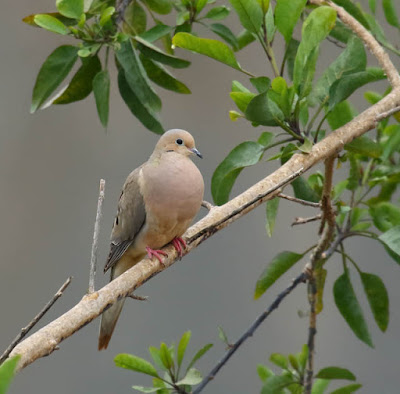 |
| Mourning Dove. Greg Gillson |
Range in Florida: Mourning Doves are year-round residents throughout Florida.
Identification: This is a key species for comparing with an unknown bird.
Size: About 12 inches long from bill tip to tail tip. About same size as Northern Flicker. Larger than American Robin. Slightly smaller than domestic city pigeon.
Shape: Very plump with a small round head. Tail is long and pointed. Legs are short.
Bill: Small and rather slender.
Color: Pale brown-pink body, darker wings and tail. White edges on side of tail.
Habitat, range & behavior: Semi-open areas such as urban areas, farmlands, woods. Often seen perched on wires, fences.
They are resident across the lower-48 states and Mexico, with some movement out of northern areas in winter.
Their mournful cooing is a familiar spring birdsong.
Food and feeder preference: Mourning Doves eat seeds almost exclusively. Attract with black oil sunflower seeds on a large sturdy tray feeder or on the ground.
3. Red-bellied Woodpecker (Melanerpes carolinus)
This is one of the most common species in the eastern half of the United States.
 |
| Red-bellied Woodpecker. skeeze from Pixabay |
Range in Florida: Red-bellied Woodpeckers are year-round residents throughout Florida.
Identification:
Size: Fairly large for a backyard bird. Between a Starling and American Robin in size. Smaller than a Northern Flicker.
Shape: Stout with large head and short tail. Clings to tree trunk on strong short legs propped up with short stiff tail.
Bill: Long, chisel-shaped.
Color: Pale gray body, many thin black-and-white bars across back and wings. Red nape, extending forward on crown on male.
Habitat, range & behavior: These birds are found in many woodland types, including oak, hickory and pine.
They are found from the eastern slope of the Rocky Mountains in the lower-48 states from Texas to extreme southern Canada, and eastward from Florida northward just to the southern edge of the New England states.
In typical woodpecker fashion, it hitches up the tree trunk and larger branches.
Food and feeder preference: This species eats insects and nuts. They may eat peanuts from a tray feeder and eat from a suet block.
4. Northern Mockingbird (Mimus polyglottos)
This common bird sings from exposed perches most of the year and often through the night. They have an unending supply of their own unique short phrases that they repeat about 3 times each, but frequently intersperse songs of other birds.
 |
| Northern Mockingbird. Greg Gillson |
Range in Florida: Northern Mockingbirds are year-round residents throughout Florida.
Identification:
Size: The length of an American Robin.
Shape: Slender and long-tailed. Long legs.
Bill: Medium length, slender, slightly curved.
Color: Gray, darker above, with white patches in wing and tail.
Habitat, range & behavior: They prefer edge habitat with scattered trees and bushes, parks and residential areas.
They are found in eastern and southern parts of the US, West Indies, and south into Mexico. In summer birds are found a bit farther north.
They boldly defend their nests from other birds, cats, and intruders.
Food and feeder preference: Eats insects, berries, and fruit. You may attract mockingbirds to your feeder with grapes, raisins, apple slices. They will come to a suet block. They readily use a bird bath.
5. Blue Jay (Cyanocitta cristata)
A common and well-known backyard bird in the eastern half of the United States.
 |
| Blue Jay. skeeze from Pixabay |
Range in Florida: Blue Jays are year-round residents throughout Florida.
Identification:
Size: About that of American Robin.
Shape: Fluffy, large crested head, ample tail. Large strong legs.
Bill: Black, long and stout.
Color: Blue above, white below. Black neck strap. White patches in wing.
Habitat, range & behavior: Woodlands and towns.
They live in the eastern half of the United States. In summer into southern Canada.
Bold and brash. May bully smaller birds. Jays gulp lots of seeds or other food at once, storing it in their crop. Then they fly off and bury food items in a hidden cache.
Food and feeder preference: Omnivorous. They can quickly empty your feeder! Because they are also aggressive toward other feeder birds, some people put mesh cages around smaller bird feeders. Small birds can go through, squirrels and larger “pest” birds are prevented entry. Some people feed jays peanuts, perhaps away from the seed feeders.
6. Palm Warbler (Setophaga palmarum)
This little warbler is probably more likely feeding on the ground under bushes on the edge of your yard.
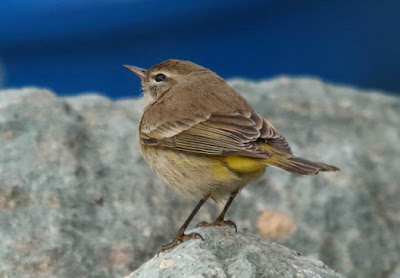 |
| Palm Warbler. Greg Gillson |
Range in Florida: Palm Warblers winter throughout Florida.
Identification:
Size: This is a smaller bird, between a goldfinch and House Finch in size.
Shape: Plump with a short neck and longer tail and long legs.
Bill: Rather short, slender, pointed.
Color: During winter rather drab with yellow under tail coverts. In breeding plumage has yellowish under parts and rusty cap.
Habitat, range & behavior: Brushy, open areas. Breed in spruce bogs. In winter often found on open patches of bare soil along fence rows with scattered bushes. Also, marshes, grassy lawns and agricultural edges.
Breed in Canada. Winter primarily in the southeastern United States and West Indies. Some along the West Coast.
Walks on the ground, constantly wagging tail.
Food and feeder preference: They mostly eat insects and some berries. May be attracted to backyard suet feeders.
7. Carolina Wren (Thryothorus ludovicianus)
This is a fairly common backyard bird in the much of the eastern United States.
 |
| Carolina Wren. theSOARnet from Pixabay |
Range in Florida: Carolina Wrens are year-round residents throughout Florida.
Identification:
Size: A smaller bird, between the size of American Goldfinch and House Finch.
Shape: Round body, short neck, flat head, long tail flipped about actively.
Bill: Fairly long, thin, pointed and slightly curved.
Color: Upper parts rusty brown with black bars on the wings and tail. A white eyebrow line and buff under parts.
Habitat, range & behavior: Shrubby thickets and brushy suburban yards.
It is found in the southeastern United States and Yucatan. Northern parts of range expand and contract depending upon harshness of winters.
Males sing throughout the year and are very loud for their size.
Food and feeder preference: Feed mostly on insects and spiders. Attract with suet.
8. Blue-gray Gnatcatcher (Polioptila caerulea)
Your yard may need to be bordered by unmanaged thickets in order to have this rather common but shy bird visit.
 |
| Blue-gray Gnatcatcher. Greg Gillson |
Range in Florida: Blue-gray Gnatcatchers are year-round residents in most of Florida, winter residents only in the south.
Identification:
Size: Tiny. It is between a hummingbird and goldfinch in size.
Shape: Round head and long floppy tail.
Bill: Short, straight, slightly curved toward tip.
Color: Blue-gray above, white below. Black tail with white outer tail feathers that fold to become mostly white below.
Habitat, range & behavior: A bird of thickets and woodlands; riparian, juniper woodlands and chaparral in the West.
Resident in the southernmost states of the US and south into Mexico. Moves north in summer into much of mid-latitudes of the United States. In winter widespread in Middle America.
Actively forages in in outer twigs and leaves of bushes, flipping its tail about.
Food and feeder preference: They eat insects. You might try to attract them with suet or a water feature. But realistically, they want shrubby bushes to glean insects.
9. Common Grackle (Quiscalus quiscula)
Sometimes considered a pest to crops, grackles are longer and lankier than very similar blackbirds.
 |
| Common Grackle. GeorgiaLens from Pixabay |
Range in Florida: Common Grackles are year-round residents throughout Florida.
Identification:
Size: Larger than Red-winged Blackbirds, they are near the length of Mourning Doves.
Shape: Long, with long full keel-shaped tail, long legs, flat crown.
Bill: Longer than head, pointed, but stouter than other blackbirds.
Color: Glossy black with hint of bronze or green on head (depending upon population). Yellow eye.
Habitat, range & behavior: They are found in agricultural areas, woodland edges, city parks and lawns.
Resident in the southeastern United States. In summer they migrate northward and west to the central United States and Canada.
They monopolize feeders and are bullies toward other birds.
Food and feeder preference: Grain, corn, acorns, small aquatic fish and amphibians. To discourage them, use tube feeders, rather than hopper or tray feeders. Don’t over-feed, keep spilled seed picked up.
10. Yellow-rumped Warbler (Setophaga coronata)
An abundant winter visitor in southern US to treetops and weedy areas.
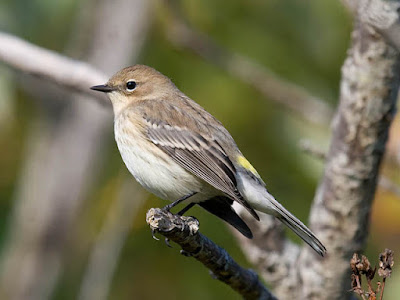 |
| Yellow-rumped Warbler. Greg Gillson |
Range in Florida: Yellow-rumped Warblers are winter visitors throughout Florida.
Identification:
Size: Small, they are a bit larger than chickadees and goldfinches. They are smaller than House Finches and juncos.
Shape: Plump and neckless with a shorter tail.
Bill: Short, slender, straight, pointed.
Color: Breeding plumage in spring is blue-gray on the upper parts, black sides and chest, yellow rump, yellow on sides.
Two forms: western form with yellow throat and large white wing patch; eastern and northern form with white throat and two white wing bars. In winter plumage both forms are gray brown above, pale cream below. Yellow rump and white tail corners in flight.
Habitat, range & behavior: In breeding season mostly in coniferous or mixed forests, in mountains in west. In winter open areas with fruiting shrubs and scattered trees.
Breed across Canada and Alaska and in conifer forests in the west. Winter along both coasts and the southern states through Middle America. There are also non-migratory forms in Mexico and Guatemala.
They tend to forage in outer branches about half way up the tree.
Food and feeder preference: Mainly insects in the summer, they switch to waxy berries and fruit in winter. They are thus able to winter farther north than other warblers. They are attracted to suet feeders.
11. Gray Catbird (Dumetalla carolinensis)
This bird is rather common where it occurs, but a bit secretive.

Range in Florida: Gray Catbirds are winter visitors throughout Florida and also nest in the extreme northern part of the state.
Identification:
Size: About the length of a Red-winged Blackbird or Northern Cardinal.
Shape: Long tailed, round head.
Bill: Medium length, pointed.
Color: Gray with a black tail and black cap. Rusty under tail coverts.
Habitat, range & behavior: Dense woodland edges, scrub, abandoned orchards.
Breeds in eastern and central US and adjoining southern Canada. Winters in extreme south US Gulf states, southward in eastern Mexico to Panama.
They spend much time hopping on the ground or in low bushes. They defend a winter territory, unlike most birds.
Food and feeder preference: Insects and berries. You may attract this species with jelly and fruit feeders, suet, and water.
12. Tufted Titmouse (Baeolophus bicolor)
Related to chickadees, these common birds lack the black bib, but have a crest instead.
 |
| Tufted Titmouse. anne773 from Pixabay |
Range in Florida: Tufted Titmice are year-round residents throughout most of Florida but absent in the farthest south.
Identification:
Size: A small bird, but a large titmouse, this species is larger than chickadees, about the size of a junco or House Finch.
Shape: Rounded body, long full tail, big head, long legs.
Bill: Short and stout, compressed (taller than wide), black.
Color: Dark blue-gray above, pale below. Black feathers around eye accentuates its size.
Habitat, range & behavior: Lives in deciduous forests with heavy canopy, parks.
Found in eastern and southeastern United States is expanding its range north and west.
They crawl and perform short flap-hops through the twigs at the top of short trees and bushes.
Food and feeder preference: Insects and seeds. At your hopper or tray feeder attract with black oil sunflower seeds and suet.
13. Downy Woodpecker (Picoides pubescens)
This tiny woodpecker is common in backyards across the United States.
 |
| Downy Woodpecker. Greg Gillson |
Range in Florida: Downy Woodpeckers are year-round residents throughout Florida.
Identification:
Size: Bigger than a junco or House Finch. Smaller than a Red-winged Blackbird. About the same size as a White-crowned Sparrow, but with a much shorter tail.
Shape: Stocky with large head and short stiff tail.
Bill: Short, chisel-shaped.
Color: Black-and-white striped head. Black wings with white spots. Solid white back. White under parts. Black tail with white outer tail feathers with black bars or spots. Male with small red spot at back of head.
Habitat, range & behavior: Found in small deciduous trees, willows, and even weed stocks such as teasel, especially near water.
Ranges coast-to-coast across all but northernmost parts of Canada and Alaska south to the southern US. Absent in the desert southwest.
Interestingly, I learned today that the males may more often be found in smaller plants and twigs, while females are more likely on tree trunks.
Food and feeder preference: Insects, fruits, and seeds. Gleans arthropods from the bark of trees. Attract with suet feeder. Will also eat black oil sunflower seeds.
14. American Crow (Corvus brachyrhynchos)
This larger all-black bird is common in cities and country. Its cawing call is familiar to most people.
 |
| American Crow. Greg Gillson. |
Range in Florida: American Crows are year-round residents in Florida.
Identification: This is a key species for comparing with an unknown bird.
Size: About 17-1/2 inches long from bill tip to tail tip, though there is much size variation throughout its range. Larger than blackbirds and grackles. Smaller than ravens.
Shape: Thick neck, large head, rather short square-ended tail. Longer legs. In flight has rounded wing tips with each primary feather separated from others forming “fingers.”
Bill: As long as head, thick, black.
Color: Glossy black throughout.
Habitat, range & behavior: They prefer open areas with trees, fields, farms, cities.
They are common across most of the United States lower-48, except in the desert southwest. They move into southern Canada in summer.
They gather in evening communal roosts in large flocks that may number into the thousands and then move out at dawn into the surrounding area.
Food and feeder preference: Omnivorous, American Crows feed on large insects, grain, small mammals, carrion. You probably don’t want these large entirely black birds in your backyard feeders. So don’t feed table scraps to birds.
15. Pileated Woodpecker (Dryocopus pileatus)
This huge woodpecker is found in large timber.
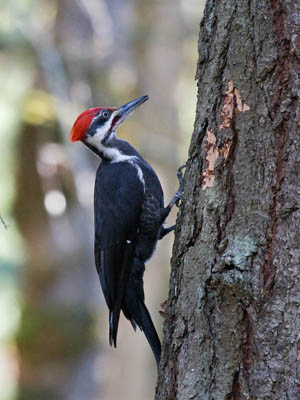 |
| Pileated Woodpecker. Greg Gillson. |
Range in Florida: Pileated Woodpeckers are year-round residents throughout Florida.
Identification:
Size: Large; the size of a crow. Bigger than a flicker.
Shape: Heavy body with a fairly long neck for a woodpecker. Big head, accentuated by large bill and flamboyant crest. Broad rounded wings. Short, wedge-shaped tail.
Bill: As long as head. Strong and chisel-shaped.
Color: Primarily black with white stripe on neck and face. Red crest. White underwing linings. White bases to the upper primaries.
Habitat, range & behavior: Found in dense mature forests with big trees.
They are found across Canada, conifer forests of the West Coast, and most of the East.
Drill with powerful strikes of their bill on trees live or dead. Look for their large rectangular holes in huge old stumps.
Food and feeder preference: Carpenter ants are their primary food. They will eat sunflowers and peanuts on platform feeders.
16. Eastern Phoebe (Sayornis phoebe)
This plain bird is common in backyards in the East.
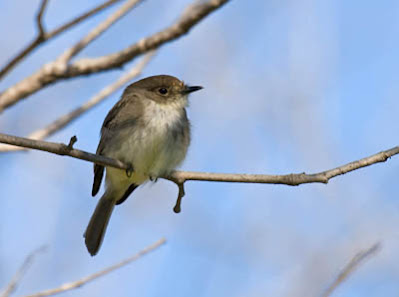 |
| Eastern Phoebe. Greg Gillson. |
Range in Florida: Eastern Phoebes are winter visitors throughout Florida.
Identification:
Size: About the size of bluebirds. Larger than House Sparrows.
Shape: Rather stout, with long wings, medium-length tail. Pointed but flat bill. Upright posture.
Bill: Black, pointed, wide and flat.
Color: Brownish-gray above, slightly yellow-olive on sides. White under tail coverts. No eye ring or wing bars help distinguish them from some other flycatchers.
Habitat, range & behavior: Found in woodlands, suburbs, farms. Frequently nest in rafters, under eaves, porches.
They are summer residents east of the Rocky Mountains from Canada southward. Year-round residents through the interior of the Southeast, to Texas. Winter visitor to Gulf Coast and southern Atlantic.
Phoebes pump their tail down. They also frequently spread their tails.
Food and feeder preference: They eat flying insects that they catch on the wing. Not a feeder visitor.
17. Northern Parula (Setophaga americana)
This is a fairly common bird in the East.

Range in Florida: Northern Parulas are year-round residents in the mid-latitudes of Florida, summer residents in northern Florida, and winter visitors in southern Florida.
Identification:
Size: Small bird. Smaller than a chickadee. Smaller than many other warblers.
Shape: Round body and head. Short tail.
Bill: Short and sharply-pointed. Bill is dark above and yellow below.
Color: Blue-gray above. Back is green. Two bold white wing bars. Chest is yellowish, the male has a partial dark orange and black band across the chest.
Habitat, range & behavior: These birds are found in conifer or mixed woods in trees with hanging with Spanish moss and lichens, often near water.
They are found in summer from the eastern parts of southern Canada, south through the Eastern United States. Winter in Florida, otherwise south of the US.
They glean at the tips of foliage. They may hover or hang upside down.
Food and feeder preference: Invertebrates are their primary food. May come to suet feeder.
18. White-eyed Vireo (Vireo griseus)
Vireos are rather sluggish compared to other forest birds like warblers. They may be hard to see as they move slowly through the foliage.
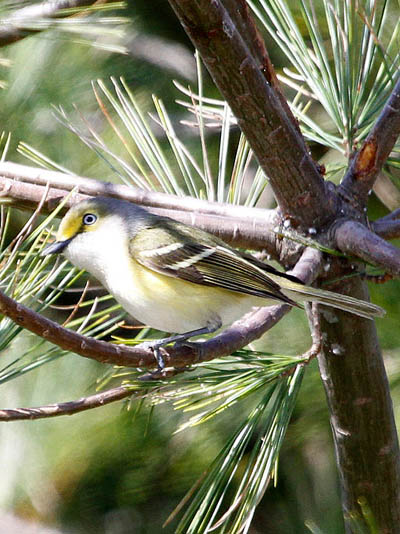 |
| White-eyed Vireo. Chuck Homler CC 3.0 |
Range in Florida: White-eyed Vireos are year-round residents throughout Florida.
Identification:
Size: About the size of an American Goldfinch or chickadee. Smaller than a Dark-eyed Junco.
Shape: Fairly chunky. Large head. Medium tail that sticks straight out behind.
Bill: Short, but stout and hooked at the tip.
Color: Mostly gray-olive above. White below, with yellow tint on sides and flanks. Yellow spectacles. Two white wing bars.
Habitat, range & behavior: Found in scrubby habitats, forest edges, mangroves.
Year-round resident in coastal Southeast. Summer resident more extensively northward in the Eastern US.
Like other vireos, White-eyed Vireos sing throughout the heat of day in summer, when most other birds are quiet.
Food and feeder preference: They eat primarily insects, but also small fruits and berries in fall and winter. They are not attracted to bird feeders.
19. European Starling (Sturnus vulgaris)
Introduced to North America in the late 1800’s, they crossed the continent, often to the detriment of native cavity-nesting birds. The prime example of an invasive species.
 |
| European Starling. Greg Gillson. |
Range in Florida: European Starlings are year-round residents throughout Florida.
Identification:
Size: About the size of a Red-winged Blackbird. Smaller than an American Robin. Larger than a White-crowned Sparrow or Spotted/Eastern towhee.
Shape: Stocky with large head, short square-ended tail. Longer legs.
Bill: As long as head. Sharp pointed. Yellow in spring, otherwise dark.
Color: They are grayish brown much of the year, with glossy iridescence and white spotting during the spring.
Habitat, range & behavior: Lowland birds that need trees large enough for nest cavities but plenty of open area for feeding. They are most abundant in urban and suburban areas where they find food and artificial nest cavities.
Resident from coast-to-coast from southern Canada to northern Mexico. In summer north across Canada and Alaska. Native range is Europe to Pakistan, north Africa.
Often viewed as a pest, starlings often bully other backyard birds, taking over bird feeders, and stealing nest cavities from smaller native birds.
In winter they can form into flocks of ten’s of thousands.
Food and feeder preference: European Starlings eat primarily insects when available, often feeding on the ground. Discourage them from your backyard hopper and tray feeders by never feeding birds table scraps (including bread or meat). They have weak feet and do not perch well on tube feeders. A cage mesh around smaller hopper feeders may keep them out.
20. American Robin (Turdus migratorius)
This familiar bird is a common resident in the northern half of the United States and a winter visitor to backyards in the southern half.
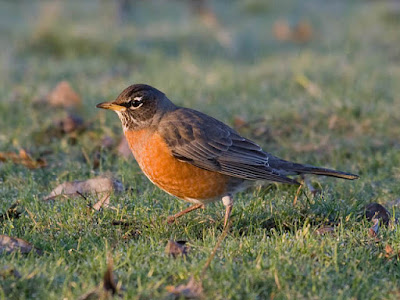 |
| American Robin. Greg Gillson. |
Range in Florida: American Robins are winter visitors throughout Florida, breeding in the extreme northern part of the state.
Identification: This is a key species for comparing with an unknown bird.
Size: 10 inches long from bill tip to tail tip. About the same size as a Blue Jay or one of the Scrub-Jays. Larger than Red-winged Blackbird. Smaller than a Mourning Dove.
Shape: Very plump with a fairly long tail.
Bill: Straight and fairly slender, curved at the tip.
Color: Gray-brown upperparts, rusty orange breast.
Habitat, range & behavior: Open woodlands, farmlands, urban parks and lawns.
Migratory, breeds north across Alaska and Canada. Resident in most of the United States (lower 48). Winters in the United States, Mexico, to central America.
Hops on your lawn turning head this way and that looking for food. Their caroling song is one of the early signs of spring in the north.
Food and feeder preference: American Robins eat earthworms and other invertebrates in the lawn. May eat fruit from a tray feeder or the ground. Eat small berries from trees and bushes.
21. Tree Swallow (Tachycineta bicolor)
Look for these birds high in the air or swooping low over the water chasing flying insects.
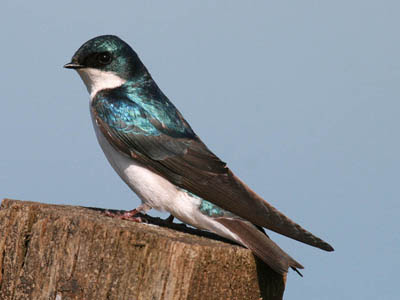 |
| Tree Swallow. Greg Gillson. |
Range in Florida: Tree Swallows are winter visitors throughout Florida.
Identification:
Size: These birds are rather small, about the length of American Goldfinches.
Shape: Long body with short tail. Neck short. Wings long and pointed.
Bill: Very short, but wide.
Color: These birds are shiny metallic blue above and bright white below. Males have a black mask.
Habitat, range & behavior: These birds are almost always found near or over water.
They breed in summer across almost all of North America, Alaska across Canada and south throughout all but the dry southwestern deserts and southernmost states of the United States. In winter they are found along southern coastal states, southward into Mexico.
Look for Tree Swallows swooping high or low over ponds, lakes, wetlands.
Food and feeder preference: Tree Swallows chase flying insects and feed on the wing. They won’t come to feeders but will use nest boxes along waterways.
22. Pine Warbler (Setophaga pinus)
These well-named birds are residents in the Southeast and early spring migrants in the East.
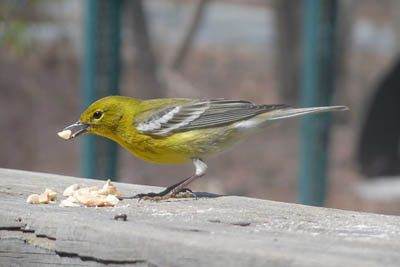 |
| Pine Warbler. Nikolaus Schultz from Pixabay. |
Range in Florida: Pine Warblers are year-round residents throughout most of Florida, except for the southern tip where they are winter visitors only.
Identification:
Size: A smaller bird, a little longer than a goldfinch.
Shape: These birds have a typical warbler shape, compact with a longer tail.
Bill: Fairly long, sharply pointed.
Color: These are kind of a dull yellowish-green on the head and back. The breast is more yellowish, especially in males. There are some dull greenish streaks on the breast. The wings and tail are rather gray, with two bold white wing bars. The under tail covert and lower belly is white.
Habitat, range & behavior: Almost always found in pines.
Year-round resident in the Southeast; summer resident in the eastern United States northward to southernmost Canada.
Tend to stay high in the pines, where often detected by their dry trilled song.
Food and feeder preference: Usually insects. However, these are one of the few warblers to eat seeds. They will feed on millet and sunflower seeds at hopper feeders. Also attract with suet.
23. Great Crested Flycatcher (Myiarchus crinitus)
These larger flycatchers feed toward the top of the canopy within woods.
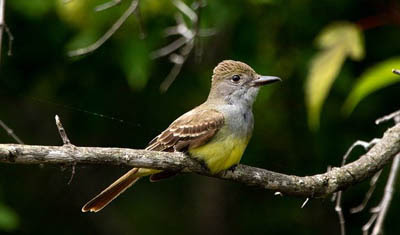 |
| Great Crested Flycatcher. Simard Francois from Pixabay. |
Range in Florida: Great Crested Flycatchers are year-round residents in southernmost Florida, summer residents only in most of Florida.
Identification:
Size: These are fairly large flycatchers, about the size of Red-winged Blackbirds. They are much smaller than robins.
Shape: Lanky, these birds have long full tails and big heads.
Bill: The bill is fairly long and stout. Wide and pointed.
Color: Fairly dull green-brown back, wings, tail. Gray head and upper breast. Yellow belly and under tail coverts. Thin dull wing bars. Undertail is rusty orange.
Habitat, range & behavior: They stick to the upper parts of trees in broken woodlands.
They are summer residents throughout the East, and adjacent southern Canada. Most winter in Central America, though there are some all year in southern Florida.
These birds nest in cavities, so will accept nest boxes, such as those for bluebirds.
Food and feeder preference: They eat insects and fruits. They probably will not come to feeders.
24. Chimney Swift (Chaetura pelagica)
Swifts have such small weak feet that they cannot perch on wires or trees like swallows. Look for them high in the air chasing bugs with rapid wingbeats.
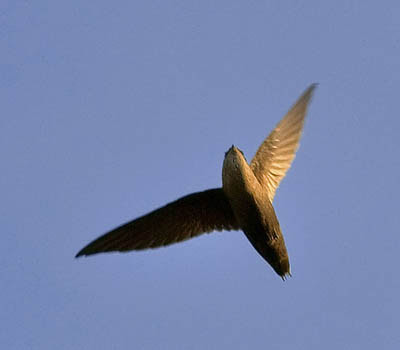 |
| Chimney Swift. Jim McCulloch CC 2.0 |
Range in Florida: Chimney Swifts are summer residents throughout Florida.
Identification:
Size: Small bird. Smaller than House Finches or Cliff Swallows.
Shape: Small head on short neck, very short tail. Thin pointed wings with no apparent bend at the wrist as most other birds.
Bill: Very short, wide.
Color: Gray-brown throughout.
Habitat, range & behavior: Open sky, above forests or residential areas.
They are summer residents east of the Rockies from southern Canada southward. They do not winter in the United States.
In fall migration they form large flocks of hundreds or thousands and swirl into large chimneys at dusk. Because the upper arm is so short as to barely exist, the flight of swifts is described as rapid and twinkly, not smooth and graceful as swallows.
Food and feeder preference: Insects caught on the wing. Will not visit feeders.
25. Eurasian Collared-Dove (Strptopelia decaocto)
These large pale pigeons have only been in the United States since invading Florida in 1983. But they have taken over much of the continent.
 |
| Eurasian Collared-Dove. Greg Gillson. |
Range in Florida: Eurasian Collared-Doves are year-round residents throughout Florida.
Identification:
Size: Large pigeon. Larger than Mourning Dove. Same size as domestic pigeon.
Shape: Full plump breast. Round head. Long square tail.
Bill: Small.
Color: Cream-colored, may be slightly warmer brown on back or, conversely, may be nearly white. Black hind neck mark. Broad white band at end of tail. From underneath when perched on wire, note the black base to the underside of the tail.
Habitat, range & behavior: These pigeons are found in residential areas and farmlands. Look for them perched on electric lines or in trees.
They are year-round residents in residential areas throughout almost all of the United States, except rare in the Northeast.
A pair of birds nest in one area nearly year-round, then build in numbers over a couple of years. Then several birds from the group fly up to 500 miles and set up a new colony. In this way this species took over much of Europe in the last century, and most of North America, starting from Florida in 1983 (from birds escaped from or vagrant in Bahamas).
Food and feeder preference: Eat grain. Will eat all seeds at bird feeders. Large, hungry, and often visit feeders in groups.
26. Common Ground Dove (Columbina passerina)
These are tiny, sparrow-sized doves of open and agricultural areas. Their scientific name Columbina means little dove, and passerina means sparrow–small indeed! Their English name changed in 2019 from Ground-Dove to Ground Dove!
 |
| Common Ground Dove. Greg Gillson. |
Range in Florida: Common Ground Doves are year-round residents throughout Florida.
Identification:
Size: Tiny. The size of fat House Sparrows. Much smaller than Starlings and any other doves.
Shape: Plump. Small round head. Short tail. Short round wings.
Bill: Small, pink at base.
Color: Upper parts gray-brown, with scaling on the pinkish breast and some dark spots on the wing coverts. Birds in the Southeast are more richly colored. In flight note the rufous base to the primaries on the upper wing and entirely rufous under wing.
Habitat, range & behavior: Found on open dusty ground, agricultural areas.
They are found across the southern United States from southern California to Florida.
They spend most of their time on the ground searching for food. When they fly their wings make a rustling or rattling sound.
Food and feeder preference: They eat small seeds. They will visit feeders for millet and other small seeds. They also are fond of water features on the ground.
27. Red-winged Blackbird (Agelaius phoeniceus)
These noisy flocking birds are most often found in marshes. But in winter they are found in backyards.
 |
| Male Red-winged Blackbird. Greg Gillson. |
 |
| Female Red-winged Blackbird. Greg Gillson. |
Range in Florida: Red-winged Blackbirds are year-round residents throughout Florida.
Identification: This is a key species for comparing with an unknown bird.
Size: About 8-3/4 inches long from bill tip to tail tip. About the size of a Northern Cardinal. Smaller than an American Robin.
Shape: Pot-bellied with a longer bill and flat forehead. Tail average.
Bill: Long and sharp pointed.
Color: Males are black with red and yellow shoulder patch. Females are streaked brown and rusty (sparrow-like but pointed bill and flat forehead).
Habitat, range, and behavior: Cattail marshes and wetlands are their summer habitat. In winter they feed in grain fields.
They breed across most of the North American continent. In winter they withdraw from most of Alaska and Canada.
They are found in colonies in summer and large flocks in winter.
Food and feeder preference: They eat insects in summer. In winter they eat grain and seeds. They visit feeders, more often in large winter flocks, and eat most seeds and suet.
Common Birds in Florida
To determine how common each species is I used the data from actual bird sightings from the citizen science program eBird. Birds are listed by frequency. That is, how often the species is recorded on checklists submitted to eBird (a percentage).
When choosing the birds to include in this article I leaned strongly to birds that are present throughout the year in good numbers. Thus, many of the common birds are year-round residents. This means that they live in the same location all year. They raise their young in your neighborhood. They don’t migrate. Or if the species does migrate, the ones living in your area don’t. If this is the case, some migrants may move into your area during certain times of year, adding to the same species that are in your yard full time.
Some migrant birds visit your yard during the “summer.” Often, they arrive in spring and remain until late fall. They nest and raise their young in your neighborhood. These are the summer residents.
Other migrant birds visit your backyard during the “winter.” Some of these winter visitors may arrive in July and remain into April. Others may only be found in the cold of December or January. They key here is that they nest and raise their young somewhere else. They only visit your yard in the non-breeding season.
Migration is an amazing spectacle.
There will be birds that fly through your region in spring or fall (or both). They may visit your backyard only a few days or weeks a year. They aren’t regular enough, or stay long enough, to be included in this article. But the number of briefly visiting migrant birds could double the number of species presented here. You may see them over time. Consult checklists in eBird for your county to see what is possible.
I have generally excluded common waterfowl, birds of prey, shorebirds, seabirds, and others that aren’t usually found in residential areas. But they may certainly fly over or be seen regularly if your home is on a shoreline, for instance.
Most common backyard birds in Florida throughout the year
The following list is the backyard birds that, on average, are most common throughout the entire year.
The list is ordered by most common based on the frequency of how often birds are recorded on checklists submitted to eBird.
- Northern Cardinal (46% frequency)
- Mourning Dove (42%)
- Red-bellied Woodpecker (40%)
- Northern Mockingbird (39%)
- Blue Jay (34%)
- Palm Warbler (26%)
- Carolina Wren (24%)
- Blue-gray Gnatcatcher (24%)
- Common Grackle (21%)
- Red-winged Blackbird (21%)
- Yellow-rumped Warbler (20%)
- Gray Catbird (20%)
- Tufted Titmouse (18%)
- Downy Woodpecker (18%)
- American Crow (16%)
- Pileated Woodpecker (15%)
- Eastern Phoebe (14%)
- Northern Parula (14%)
- White-eyed Vireo (12%)
- European Starling (12%)
Most common backyard birds in Florida in winter
- Palm Warbler (39% frequency)
- Yellow-rumped Warbler (38%)
- Northern Cardinal (38%)
- Mourning Dove (37%)
- Red-bellied Woodpecker (36%)
- Northern Mockingbird (34%)
- Blue Jay (28%)
- Blue-gray Gnatcatcher (27%)
- Eastern Phoebe (26%)
- Gray Catbird (23%)
- Red-winged Blackbird (20%)
- American Robin (17%)
- Tree Swallow (14%)
- Pine Warbler (12%)
You may enjoy reading my article: Feeding winter birds in Florida
Most common backyard birds in Florida in summer
- Northern Cardinal (51% frequency)
- Mourning Dove (50%)
- Northern Mockingbird (42%)
- Red-bellied Woodpecker (39%)
- Blue Jay (34%)
- Carolina Wren (27%)
- Red-winged Blackbird (24%)
- Common Grackle (23%)
- Tufted Titmouse (19%)
- Great Crested Flycatcher (18%)
- Chimney Swift (12%)
- Eurasian Collared-Dove (12%)
- Common Ground-Dove (12%)
Two migrant warblers actually are more frequent than the cardinal in winter. And notice how Mourning Dove is almost as common as the Northern Cardinal. The Eastern Phoebe and Gray Catbird are primarily winter visitors.
The Carolina Wren and Great Crested Flycatcher are more expected in summer. For the flycatcher, which is migrant, this makes sense. Perhaps the resident wren is detected more frequently in summer because of its loud and obvious song, even if it hides in the shadowy tangles.
Common Backyard Birds of Miami, Florida
 |
| Eurasian Collared-Dove. Greg Gillson |
- Northern Mockingbird (43%)
- Northern Cardinal (35%)
- Red-bellied Woodpecker (33%)
- Palm Warbler (30%)
- Blue Jay (30%)
- Mourning Dove (30%)
- Blue-gray Gnatcatcher (28%)
- European Starling (26%)
- Eurasian Collared-Dove (25%)
- Gray Catbird (23%)
- Prairie Warbler (18%) Learn about this species on eBird
- Northern Parula (17%)
- Common Grackle (17%)
The first thing that stands out are the urban-dwellers: European Starling and European Collared-Doves. The Prairie Warbler and Northern Parula are resident in the Miami area, but not the entire state. And look how common the Mockingbird is compared to the state as a whole.
What’s missing from this list of common birds? Carolina Wren, Yellow-rumped Warbler, Tufted Titmouse, Downy Woodpecker: woodland birds. These are father down the list.
Everything about this list of common birds in the Miami area compared with the rest of the state of Florida screams urban habitat.
Common Backyard Birds of Orlando, Florida
Here are the most common backyard birds throughout the year in Orlando:
- Northern Cardinal (57% frequency)
- Red-bellied Woodpecker (48%)
- Mourning Dove (45%)
- Northern Mockingbird (39%)
- Blue-gray Gnatcatcher (38%)
- Blue Jay (37%)
- Palm Warbler (36%)
- Fish Crow (36%) Learn about this species on eBird
- Carolina Wren (35%)
- Boat-tailed Grackle (35%) Learn about this species on eBird
- Red-winged Blackbird (32%)
- Common Grackle (31%)
- Tufted Titmouse (28%)
- Downy Woodpecker (28%)
- Gray Catbird (26%)
- Eastern Phoebe (22%)
- Yellow-rumped Warbler (22%)
- American Crow (20%)
- Common Yellowthroat (19%)
- Northern Parula (18%)
Common Backyard Birds of Tampa, Florida
- Northern Cardinal (53% frequency)
- Mourning Dove (51%)
- Blue Jay (50%)
- Red-bellied Woodpecker (49%)
- Northern Mockingbird (40%)
- Tufted Titmouse (35%)
- Carolina Wren (32%)
- Fish Crow (32%) Learn about this bird on eBird
- Blue-gray Gnatcatcher (27%)
- Downy Woodpecker (27%)
- Palm Warbler (27%)
- Common Grackle (25%)
- Red-winged Blackbird (24%)
- Boat-tailed Grackle (24%) Learn about this bird on eBird
- Gray Catbird (17%)
Wrapping Up
Florida boasts a vibrant and diverse bird community, thanks to its varied habitats, warm climate, and position as a migratory crossroads. Here are some of the most common birds you’re likely to encounter outside of your backyard across the Sunshine State:
Water Birds:
- Great Blue Heron: Tall and majestic, these wading birds with long legs and blue-gray feathers patiently stalk fish along shorelines.
- Great Egret: The largest of the white egrets, often seen standing silently in wetlands or gracefully taking flight with their broad wings.
- Brown Pelican: Masters of the dive, these large birds with long bills and pouches plunge headfirst into water to catch fish.
- Double-crested Cormorant: Black, diving birds with hooked beaks, often seen drying their wings on rocks or pilings.
- Laughing Gull: White gulls with black heads and mischievous yellow bills, known for their loud, raucous laughter-like calls.
Forest Birds:
- Florida Scrub Jay: Endemic to Florida, these blue-gray jays with a white eyebrow and long tail are found in scrub oak habitats.
- Red-bellied Woodpecker: Loud drummers with bright red heads and black backs, common in wooded areas and backyards.
- Eastern Cottontail Rabbit: Not technically a bird, but their playful hops and twitchy noses often delight birdwatchers in forest undergrowth.
- Turkey Vulture: Large, soaring birds with red heads and wingspans reaching up to 9 feet, scavenging for carrion.
- Pileated Woodpecker: The largest woodpecker in North America, with a striking red crest and loud drumming calls that echo through the woods.
Frequently Asked Questions
What is the state bird of Florida?
The Northern Mockingbird is the official state bird of Florida!
It has held this title since 1927, chosen for its beautiful singing abilities, mimicking the sounds of other birds and even insects. These greyish-white birds with long tails are common throughout the state and play a helpful role in controlling insects and weed seeds.
However, there have been recent discussions about potentially changing the state bird. Some consider the mockingbird not to be as representative of Florida’s unique ecology as other species, such as the Florida scrub jay, flamingo, osprey, or even the American alligator! Whether the change will actually happen remains to be seen, but it’s an interesting topic of debate among Floridians.
What is the noisy bird in Florida?
Limpkin are an unusual bird with a wailing call found primarily in Florida. Finding them requires knowing their preferred habitat and timing your visit right. Here’s how to increase your chances of spotting these fascinating birds:
Habitat:
- Freshwater Wetlands: Limpkins primarily dwell in freshwater marshes, swamps, mangroves, and along the shores of lakes, rivers, and streams. Look for areas with dense vegetation, shallow water, and plenty of apple snails, their main food source.
- Specific Locations: Some known hotspots for limpkin sightings include:
- Everglades National Park (especially Shark Valley Trail)
- Big Cypress National Preserve
- Merritt Island National Wildlife Refuge
- Canaveral National Seashore
- Okeechobee Wilderness Area
- Loxahatchee River Natural Area
Timing:
- Early mornings: Limpkins are most active at dawn and dusk, so plan your visit for these times.
- Year-round: They are resident birds in Florida, so you can potentially find them any time of year. However, their numbers may be slightly higher during breeding season (February to June).
What Florida bird looks like a blue jay?
The Florida scrub jay is a fascinating bird, both beautiful and ecologically important. Here’s a closer look:
Appearance:
- Blue and gray: They have a striking plumage with blue head, wings, and tail, and a pale gray back and belly.
- Long tail: Their most distinctive feature is their long, blue tail, often held upright.
- White forehead: A small white patch on their forehead adds to their charm.
- Size: Similar in size to a blue jay, but slightly smaller, about the size of a robin.
Habitat:
- Endemic to Florida: You won’t find these jays anywhere else in the world! They are exclusive residents of the Sunshine State.
- Scrub oak: They prefer low-growing oak scrub, with sandy soils and open patches. These habitats are unfortunately getting rarer due to development.
Behavior:
- Cooperative breeders: Florida scrub jays are one of the few cooperative breeders in North America. Young from previous years stay with the family group and help raise chicks, defend territory, and watch for predators.
- Intelligent: These birds are remarkably intelligent and social. They communicate with each other using complex calls and mimic sounds of other birds and even some small mammals.
- Acorns: Acorns are their primary food source, and they bury thousands of them in the ground, creating a “granary” to access later. This behavior also helps disperse oak trees, contributing to forest regeneration

Related: 34 of the most common birds in the United States (with photos)
Feeding winter birds in Florida









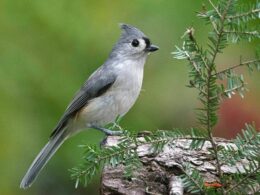
Hi and thank you for the info – it would be nice to be able to take a pic and have an app id the type of bird…
Lynn,
You are talking about the FREE Merlin app. It does just as you ask!
https://merlin.allaboutbirds.org/
Thank you for this good information! This month (early March), you've helped me identify and enjoy Chipping Sparrows. Last month, migrating warblers visited my feeder frequently. Seven year-round birds eat regularly. The information you provide has helped me make some adjustments in what I put in my feeders. Great site!
Dear Birdlady, your comments make me so happy!
This response is exactly what I hoped when creating this site. That I could help people identify some common birds, and make bird feeding more successful.
Thanks!
Great information, Thank you
You are welcome, Simi
Great info as I sit on my patio in So Fla. Watching the neighborhood birds.
Sounds wonderful. Glad I could contribute.
Fantastic website…tons of info!
Thanks!